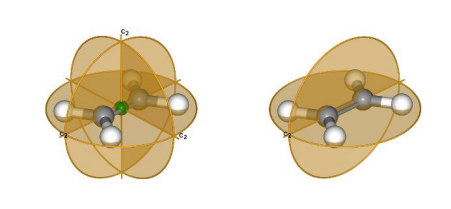Marco D'Abramo vi invita al seminario:
Ultrafast probing of isotope-induced explicit symmetry breaking in ethylene
di Alessandro Nicola Nardi, Nantes Université, France
Il seminario si terrà giovedì 2 ottobre alle ore 10:30 in Aula C, edificio Cannizzaro (CU014).
Abstract
Symmetry and symmetry breaking have been known to play a central role in contemporary physics and many of the natural phenomena occur due to the breakdown of symmetry [1].
Here, we show how isotope-induced inversion symmetry breaking influences ultrafast photoisomerization processes in ethylene. Extreme ultraviolet pump – near infrared probe time-of-flight mass spectrometry, performed replacing one of the carbon atoms in ethylene with a 13C isotope leads to twice-faster structural relaxation in the photo-excited molecular
cation. In particular, the ethylene to ethylidene conversion, i.e., the relaxation channel involving the migration of one hydrogen atom from one carbon atom to the other, also identified in previous studies [2], was affected by the isotopic effect. We simulated the quantum-classical non-adiabatic molecular dynamics, using trajectory surface hopping method, and incorporating the nuclear symmetry. Our results suggest that this difference arises from the mixing of different normal modes in the isotope-substituted species, 13C-ethylene, compared to the more symmetric unsubstituted or doubly substituted isotopologues. This facilitates efficient intra-molecular vibrational energy redistribution, thereby lowering the isomerization yield [3]. These findings offer opportunities to use isotope-induced nuclear symmetry breaking to control the outcome of light-molecule interactions across ultrafast timescales.

Figure 1. Point group symmetry elements in ethylene and 13C 13C-ethylene (left) and 13C-ethylene (right). From left to right the symmetry point group changes from D2h to C2v, with the corresponding lowering of the symmetry
References: [1] Bardeen, J., Cooper, L. N., Schrieffer, J. R. Microscopic theory of superconductivity. Phys. Rev. 106, 162 (1957); Higgs, P. W. Broken symmetries and the masses of gauge bosons. Phys. Rev. Lett. 13, 508 (1964).
[2] Fransén, L., Tran, T., Nandi, S., Vacher, M. Dissociation and Isomerization Following Ionization of Ethylene: Insights from Nonadiabatic Dynamics Simulations. J. Phys. Chem. A 128, 1457 (2024).
[3] Nardi, A. N., Boyer, A., Hu, Y., Loriot, V., Lépine, F., Vacher, M., Nandi, S. Ultrafast probing of isotopeinduced explicit symmetry breaking in ethylene. Commun. Chem., 8, 222 (2025).
Alessandro N. Nardi is currently a CNRS postdoctoral researcher at Nantes University, in the CEISAM
laboratory, where he works in Morgane Vacher’s research group as part of the ERC ATTOP project. His
research focuses on (i) the development and maintenance of algorithms for selecting the relevant
nuclear coordinates to perform non-adiabatic simulations in reduced dimensionality, and (ii) the
modeling of ultrafast coupled nuclear–electron dynamics on the attosecond to femtosecond timescales.
Prior to joining Nantes, he completed his PhD at Sapienza University of Rome under the supervision of
Marco D’Abramo, working on the theoretical and computational modeling of the electronic and
structural properties of nucleic acids in solution. He was awarded his PhD in April 2024.
